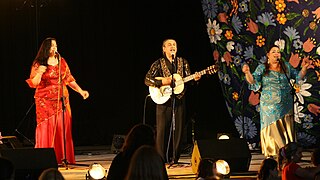
A musical saw, also called a singing saw, is a hand saw used as a musical instrument. Capable of continuous glissando (portamento), the sound creates an ethereal tone, very similar to the theremin. The musical saw is classified as a plaque friction idiophone with direct friction (132.22) under the Hornbostel-Sachs system of musical instrument classification.

A jug band is a band employing a jug player and a mix of conventional and homemade instruments. These homemade instruments are ordinary objects adapted to or modified for making sound, like the washtub bass, washboard, spoons, bones, stovepipe, and comb and tissue paper (kazoo). The term jug band is loosely used in referring to ensembles that also incorporate homemade instruments but that are more accurately called skiffle bands, spasm bands, or juke bands because they do not include a jug player.
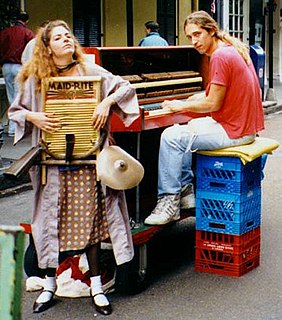
The washboard and frottoir are used as a percussion instrument, employing the ribbed metal surface of the cleaning device as a rhythm instrument. As traditionally used in jazz, zydeco, skiffle, jug band, and old-time music, the washboard remained in its wooden frame and is played primarily by tapping, but also scraping the washboard with thimbles. Often the washboard has additional traps, such as a wood block, a cowbell, and even small cymbals. Conversely, the frottoir dispenses with the frame and consists simply of the metal ribbing hung around the neck. It is played primarily with spoon handles or bottle openers in a combination of strumming, scratching, tapping and rolling. The frottoir or vest frottoir is played as a stroked percussion instrument, often in a band with a drummer, while the washboard generally is a replacement for drums. In Zydeco bands, the frottoir is usually played with bottle openers, to make a louder sound. It tends to play counter-rhythms to the drummer. In a jug band, the washboard can also be stroked with a single whisk broom and functions as the drums for the band, playing only on the back-beat for most songs, a substitute for a snare drum. In a four-beat measure, the washboard will stroke on the 2-beat and the 4-beat. Its best sound is achieved using a single steel-wire snare-brush or whisk broom. However, in a jazz setting, the washboard can also be played with thimbles on all fingers, tapping out much more complex rhythms, as in The Washboard Rhythm Kings, a full-sized band, and Newman Taylor Baker.
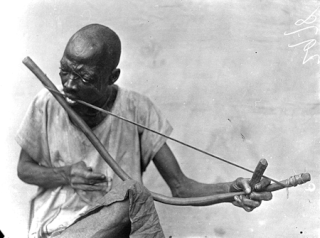
The musical bow is a simple string instrument used by a number of South African peoples, which is also found in the Americas via slave trade. It consists of a flexible, usually wooden, stick 1.5 to 10 feet long, and strung end to end with a taut cord, usually metal. It can be played with the hands or a wooden stick or branch. It is uncertain if the musical bow developed from the hunting bow, though the San or Bushmen people of the Kalahari Desert do convert their hunting bows to musical use.
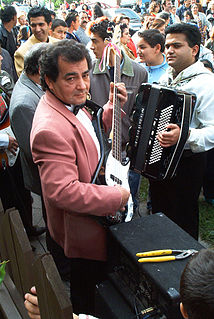
Romani music is the music of the Romani people, who have their origins in northern India, but today live mostly in Europe.
Hungary has made many contributions to the fields of folk, popular and classical music. Hungarian folk music is a prominent part of the national identity and continues to play a major part in Hungarian music. It is also strong in the Szabolcs-Szatmár area and in the southwest part of Transdanubia. The Busójárás carnival in Mohács is a major Hungarian folk music event, formerly featuring the long-established and well-regarded Bogyiszló orchestra.
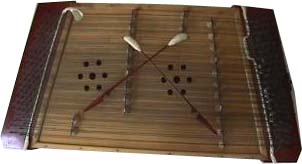
The tsymbaly is the Ukrainian version of the hammer dulcimer. It is a chordophone made up of a trapezoidal box with metal strings strung across it. The tsymbaly is played by striking two beaters against the strings.

The kaval is a chromatic end-blown flute traditionally played throughout Armenia, the Balkans and Turkey. The kaval is primarily associated with mountain shepherds.
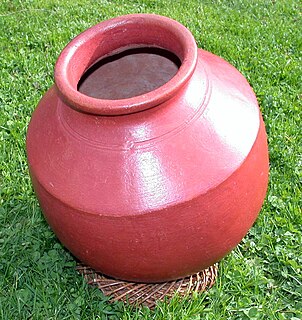
The ghaṭam is a percussion instrument used in the Carnatic music of South India. A variant played in Punjab and known as gharha as is a part of Punjabi folk traditions. Its analogue in Rajasthan is known as the madga and pani mataqa.

A standing bell or resting bell is an inverted bell, supported from below with the rim uppermost. Such bells are normally bowl-shaped, and exist in a wide range of sizes, from a few centimetres to a metre in diameter. They are often played by striking, but some—known as singing bowls—may also be played by rotating a mallet around the outside rim to produce a sustained musical note.
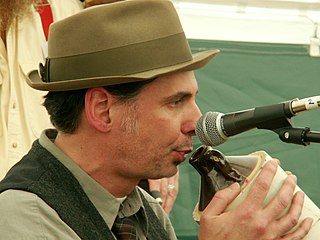
The jug used as a musical instrument is an empty jug played with buzzed lips to produce a trombone-like tone. The characteristic sound of the jug is low and hoarse, below the higher pitch of the fiddle, harmonica, and the other instruments in the band.

A jug is a type of container commonly used to hold liquids. It has an opening, often narrow, from which to pour or drink, and has a handle. Jugs throughout history have been made of metal, ceramic, glass or plastic.

Castanets, also known as clackers or palillos, are a percussion instrument (idiophone), used in Spanish, Kalo, Moorish, Ottoman, Italian, Sephardic, Swiss, and Portuguese music. In ancient Greece and ancient Rome there was a similar instrument called crotalum. The instrument consists of a pair of concave shells joined on one edge by a string. They are held in the hand and used to produce clicks for rhythmic accents or a ripping or rattling sound consisting of a rapid series of clicks. They are traditionally made of hardwood, although fibreglass is becoming increasingly popular.

Besh o droM is a gypsy music group. Their music blends folk and contemporary instruments, in styles ranging from jazz to world music. They acknowledge particular influences from Transylvanian, Jewish, Turkish, Afghan, Egyptian, Lebanese, Armenian, Bulgarian, Romanian, Macedonian and Greek musical traditions.
The term gypsy style refers to the typical way East European music is played in coffeehouses and restaurants, at parties, and sometimes on-stage, in European cities. Music played in this style is known by the general public as "gypsy music".
Hungarian metal is the heavy metal music scene of Hungary. One of the most popular and well-known band is Attila Csihar's Tormentor. Other bands include Sear Bliss, Ektomorf, FreshFabrik, Blind Myself, The Idoru and Subscribe.

Music technology is the use of any device, mechanism, machine or tool by a musician or composer to make or perform music; to compose, notate, play back or record songs or pieces; or to analyze or edit music. The earliest known applications of technology to music was prehistoric peoples' use of a tool to hand-drill holes in bones to make simple flutes. Ancient Egyptians developed stringed instruments, such as harps, lyres and lutes, which required making thin strings and some type of peg system for adjusting the pitch of the strings. Ancient Egyptians also used wind instruments such as double clarinets and percussion instruments such as cymbals. In Ancient Greece, instruments included the double-reed aulos and the lyre. Numerous instruments are referred to in the Bible, including the horn, pipe, lyre, harp, and bagpipe. During Biblical times, the cornet, flute, horn, organ, pipe, and trumpet were also used. During the Middle Ages, music notation was used to create a written record of the notes of plainchant melodies.

The angkouch is a Cambodian jaw's harp. It is a folk instrument made of bamboo and carved into a long, flat shape with a hole in the center and a tongue of bamboo across the hole. The bamboo is not removable, which makes the instrument an idioglot.




